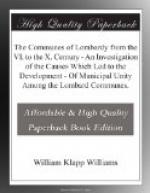In considering this phase of civil administration under the Lombard system, we are again brought face to face with the old question of the survival or non-survival of corporate existence among the cities. For if it could be proved that the municipality in its corporate capacity retained the communal property and administered it, there would appear to be good grounds for the assertion of the continuance of some form of quasi-independent municipal government; but if, on the other hand, it were found that the property of the municipality passed to the new head of local administration or to the central power, it would be evident that the continuance of the municipal system as such was a logical impossibility; for, deprived at once of its property and of its revenues, it would have had no vitality to keep it from a speedy end.
In investigating a question of this nature from the sources at our disposal in a period of history so obscure, we cannot expect to find any definite statements sufficiently precise to set at rest at once all opposition and discussion; but after considering the character of the people we are investigating and studying their institutions, and after a careful examination of the laws and records which form the sources of our information, we are, I think, in a position to be able to give a sufficiently decided opinion as to whether a particular set of facts or conditions could possibly have existed in a state of development and in a society of a given character. Thus it is in regard to the matter in hand. From the numberless cases in which the publicum is mentioned in the documents from which we draw our materials, it seems to me possible for a critical examiner to come to but one conclusion, if, as is quite essential, he take into consideration the unmistakable spirit of these writings, and if he give a legitimate interpretation to the various terms employed. To cite in direct proof any individual instance is, perhaps, impossible; but indirect evidence is forthcoming in abundance, and of a character to be, to me at least, entirely conclusive. The conclusion reached is, then, that the king and the dukes were the successors of the old curia in the possession and the administration of all properties and revenues, taxes and fines formerly belonging to the organized corporations of the Roman municipalities, and that the curtes regiae were the channel through which these were collected, divided and expended.
The grounds on which this assertion is based are the continual recurrence of examples of functions of a fiscal character being exercised by the head of the civitas and his officers, and by them alone; and it appears to me that it could only be by a complete misunderstanding of the spirit of the early writings, and by a comprehensive misapplication of the terms used in them, that these functions could be referred to any other power. These functions of the administration may be grouped under three main heads, viz: 1. Fines and forfeitures, which, of course, played a very prominent part under the Teutonic system of composition for offenses of a criminal nature; 2. Taxes and privileges, by which is meant feudal rights, dues, etc.; and 3. Buildings and lands belonging to the crown or to the head of the civitas as a public officer.




